15 Apr 2019 | Americas, Awards, Campaigns -- Featured, Cuba, Fellowship, Fellowship 2018
[vc_row][vc_column][vc_column_text]
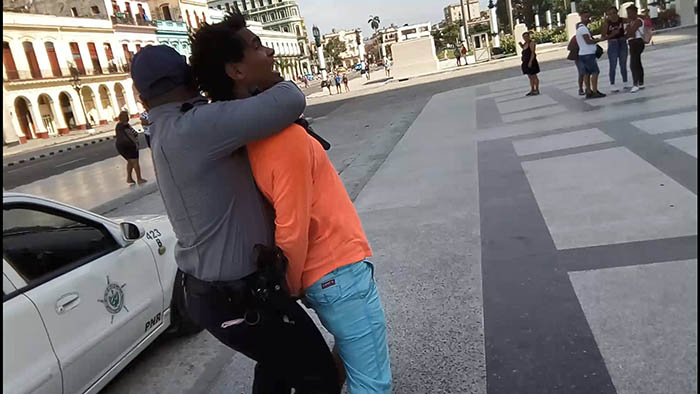
Cuban artist Luis Manuel Otero Alcantara being arrested in August 2018
Index on Censorship calls for the immediate release of Cuban artist Luis Manuel Otero Alcantara, a member of the 2018 Index on Censorship Freedom of Expression Award-winning Museum of Dissidence. This is the second time he has been arrested in two weeks.
Otero Alcantara was performing a homage to Daniel Llorente, which involved a footrace with American flags outside his home. Llorente demonstrated with the American flag in 2017 during Havana’s annual May Day celebrations. Otero Alcantara was detained along with two other artists and his whereabouts is currently unknown.
The head of Cuba’s National Council of Visual Arts, Norma Rodriguez, told Reuters in a press conference that Otero Alcantara “is an activist, not an artist”.
Michel Matus, an artist who captured Otero Alcantara’s arrest on video, wrote a statement on the harassment and threats he faced for filming and for being part of the campaign against Decree 349, a law that criminalises independent artists and places severe restrictions on cultural activity not authorised by the state. Matus was called into a police station to show the deeds to his home to prove ownership. He was interrogated for over nine hours about the campaign, his family and Otero Alcantara.
“Artists should not be criminalised for freely expressing themselves,” said Index on Censorship CEO Jodie Ginsberg. “The Cuban government should immediately release Luis Manuel and other jailed artists and end its repressive intimidation tactics.” [/vc_column_text][/vc_column][/vc_row][vc_row][vc_column][vc_basic_grid post_type=”post” max_items=”4″ element_width=”6″ grid_id=”vc_gid:1555338145410-bdabf8fe-1d1a-7″ taxonomies=”7874″][/vc_column][/vc_row]
10 Dec 2018 | Artistic Freedom, Cuba, News and features
[vc_row][vc_column][vc_column_text]
The artist Tania Bruguera who was detained last week with fellow artists in Cuba for protesting against Decree 349, an artistic censorship law, has written an open letter explaining why she will not attend Kochi biennial at a time that is crucial for freedom of expression in Cuba and beyond.
Bruguera who was due to attend Kochi states in the letter:
“At this moment I do not feel comfortable traveling to participate in an international art event when the future of the arts and artists in Cuba is at risk… As an artist I feel my duty today is not to exhibit my work at an international exhibition and further my personal artistic career but to expose the vulnerability of Cuban artists today.”
Bruguera feels it is important to highlight the situation in Cuba and also to see it as part of a global phenomenon of repression of artists and freedom of expression. Recent cases such as Shahidul Alam, the photographer imprisoned by the government of Bangladesh (who Bruguera campaigned for by hosting two protest shows at Tate Modern in October), the Saudi journalist Jamal Khashoggi killed in the Saudi embassy in Turkey, and photographer Lu Guang who has gone missing in China, demonstrate that governments feel emboldened to openly attack high profile figures, moving beyond internal state repression which used to happen behind closed doors.
On Wednesday 5 December supporters of Bruguera held a protest exhibition at Tate Modern’s Turbine Hall, where participants spoke on a microphone about Decree 349 and the abuse of artists around the world. Alistair Hudson, director of the Whitworth and Manchester Art Gallery spoke at the event via live phone in. Tate director Maria Balshaw, also spoke out on the BBC news broadcast of the Turner Prize whilst Tate Modern director Frances Morris made a statement on Tate twitter. A speech by HRH Prince Constantijn on the occasion of the 2018 Prince Claus Awards at the Royal Palace, Amsterdam on 6 December 2018 also spoke about the situation with reference to Tania Bruguera, Shahidul Alam and Lu Guang. Many other cultural institutions around the world have also made public statements, whilst others are showing signs that they will follow.
The hope is that art institutions and events around the world, such as Kochi biennial, follow suit and show open solidarity to defend the artists’ space.
The full wording of Bruguera’s letter is as follows:
OPEN LETTER BY TANIA BRUGUERA TO THE DIRECTOR OF KOCHI BIENNALE ON DECREE 349
At this moment I do not feel comfortable traveling to participate in an international art event when the future of the arts and artists in Cuba is at risk. The Cuban government with Decree 349 is legalizing censorship, saying that art must be created to suit their ethic and cultural values (which are not actually defined). The government is creating a `cultural police´ in the figure of the inspectors, turning what was until now, subjective and debatable into crime.
Cuban artists have united for the first time in many decades to be heard, each with their own points of view. They had meetings with bureaucrats from the Ministry of Culture who promised them that they would meet again to give them answers. Instead, the Minister and other bureaucrats appeared on TV and made comments such as “[those who oppose Decree 349] want the dissolution of the institution” and “the alternative they are proposing is the commercialisation of art.”
Nothing could be further from the truth. If this were true, the artists would not have written to the institutions and sought dialogue with them.
But, a public opinion campaign by the government against the artists, with the intention to divide between “good ones” and “bad ones”, has started. This is even more concerning when under this decree the law restricts but provides no guarantee of whether an artist will or will not be criminalized or not at any time.. Moreover, the decree states that all `artistic services´ must be authorized by the Ministry of Culture and its correspondent institutions, making independent art impossible.
The last time a decree of this sort was enacted was the no. 226 from November 29 of 1997, which is evidence of the long life that such a decree could have and its long term impact on our culture.
As an artist I feel my duty today is not to exhibit my work at an international exhibition and further my personal artistic career but to be with my fellow Cuban artists and to expose the vulnerability of Cuban artists today.
We are all waiting for the regulations and norms the Ministry of Culture will put forward to implement Decree 349 in the hope that they include the suggestions and demands so many artists shared with them. I would like to add that the instructor from the Ministry of Interior who is in charge of my case menaced me yesterday, saying that if I didn’t leave Cuba and if I did `something´, I would not be able to leave in the future.
Injustice exists because previous injustices were not challenged.
Ironically, I’m sending you this text on December 10th the International Day of Human Rights.
Un abrazo,
Tania Bruguera[/vc_column_text][/vc_column][/vc_row][vc_row][vc_column][vc_basic_grid post_type=”post” max_items=”4″ element_width=”6″ grid_id=”vc_gid:1544431942749-6dbcba3e-bd36-2″ taxonomies=”15469, 7874″][/vc_column][/vc_row]
5 Dec 2018 | Artistic Freedom, Awards, Cuba, Fellowship, Fellowship 2019, News and features
[vc_row][vc_column][vc_column_text]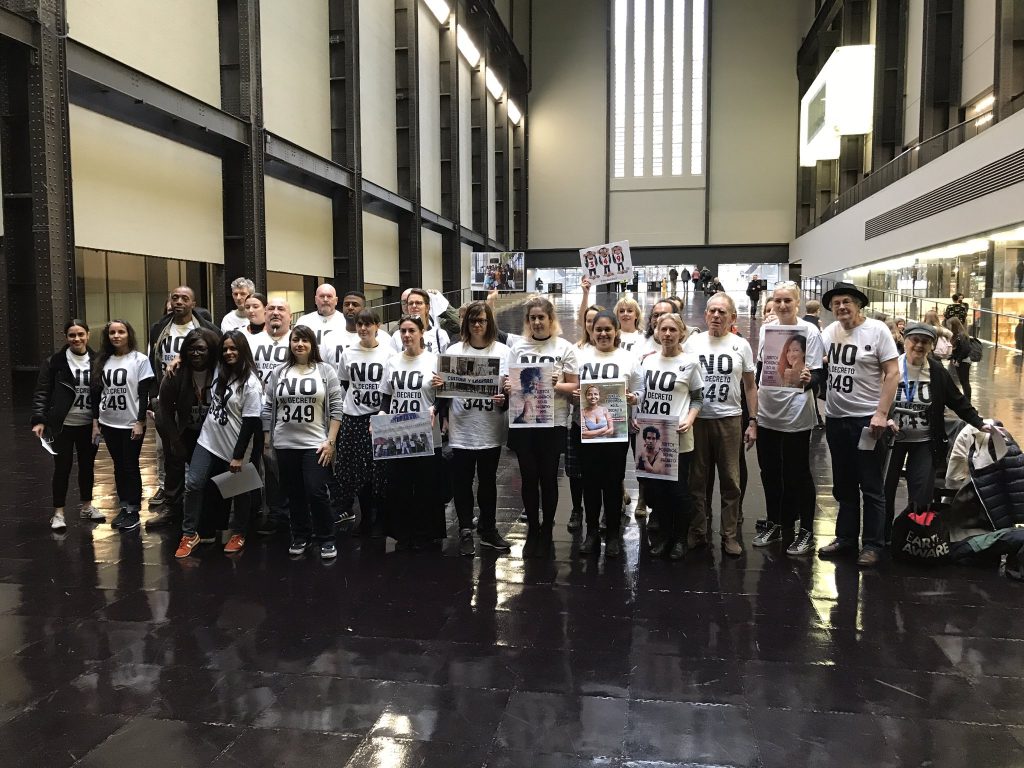
Update: All arrested artists have now been released, although they remain under police surveillance. Cuba’s vice minister of culture Fernando Rojas has declared to the Associated Press that changes will be made to Decree 349 but has not opened dialogue with the artists involved in the campaign against the decree.
Index on Censorship joined others at the Tate Modern on 5 December in a show of solidarity with those artists arrested in Cuba for peacefully protesting Decree 349, a law that will severely limit artistic freedom in the country. Decree 349 will see all artists — including collectives, musicians and performers — prohibited from operating in public places without prior approval from the Ministry of Culture.
In all, 13 artists were arrested over 48 hours. Luis Manuel Otero Alcantara and Yanelys Nuñez Leyva, members of the Index on Censorship Freedom of Expression Award-winning Museum of Dissidence, were arrested in Havana on 3 December. They are being held at Vivac prison on the outskirts of Havana. The Cuban performance artist Tania Bruguera, who was in residency at the Tate Modern in October 2018, was arrested separately, released and re-arrested. Of all those arrested, only Otero Alcantara, Nuñez Leyva and Bruguera remain in custody.
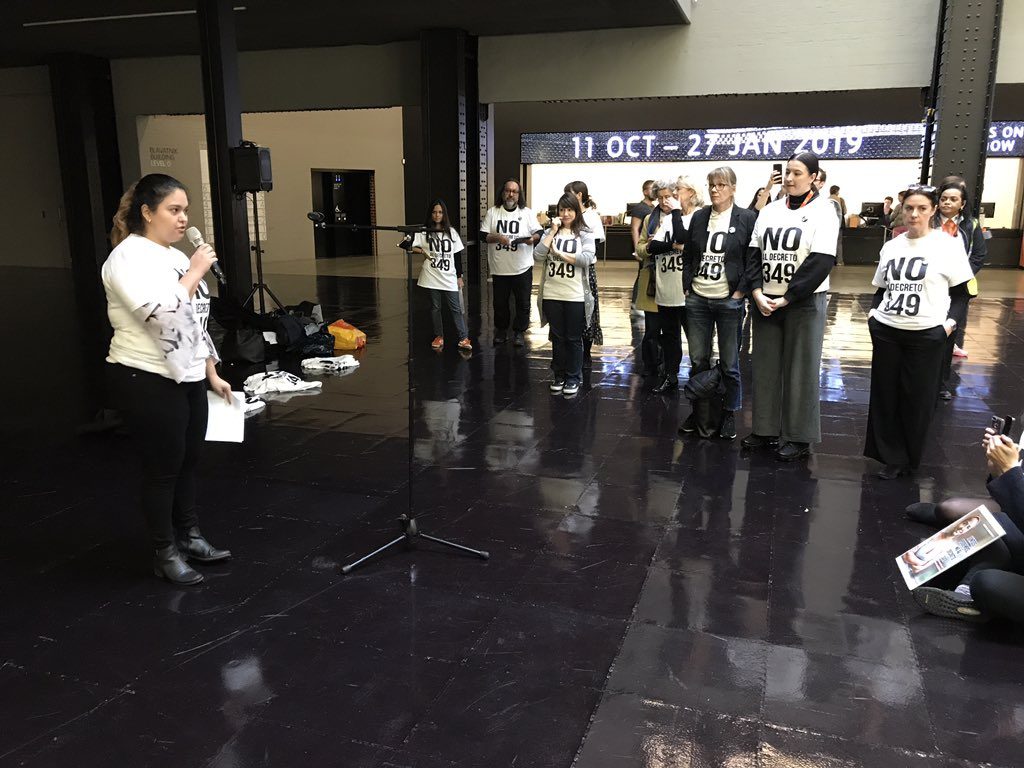
Index on Censorship’s Perla Hinojosa speaking at the Tate Modern.
Speaking at the Tate Modern, Index on Censorship’s fellowships and advocacy officer Perla Hinojosa, who has had the pleasure of working with Otero Alcantara and Nuñez Leyva, said: “We call on the Cuban government to let them know that we are watching them, we’re holding them accountable, and they must release artists who are in prison at this time and that they must drop Decree 349. Freedom of expression should not be criminalised. Art should not be criminalised. In the words of Luis Manuel, who emailed me on Sunday just before he went to prison: ‘349 is the image of censorship and repression of Cuban art and culture, and an example of the exercise of state control over its citizens’.”
Other speakers included Achim Borchardt-Hume, director of exhibitions at Tate, Jota Castro, a Dublin-based Franco-Peruvian artist, Sofia Karim, a Lonon-based architect and niece of the jailed Bangladeshi photojournalist Shahidul Alam, Alistair Hudson, director of Manchester Art Gallery and The Whitworth, and Colette Bailey, Artistic director and chief executive of Metal, the Southend-on-Sea-based arts charity.
Some read from a joint statement: “We are here in London, able to speak freely without fear. We must not take that for granted.”
It continued: “Following the recent detention of Bangladeshi photographer Shahidul Alam along with the recent murder of journalist Jamal Khashoggi, there us a global acceleration of censorship and repression of artists, journalists and academics. During these intrinsically linked turbulent times, we must join together to defend our right to debate, communicate and support one another.”
Castro read in Spanish from an open declaration for all artists campaigning against the Decree 349. It stated: “Art as a utilitarian artefact not only contravenes the Universal Declaration of Human Rights (Cuba is an active member of the United Nations Organisation), but also the basic principles of the United Nations for Education, Science and Culture (UNESCO).”
It continued: “Freedom of creation, a basic human expression, is becoming a “problematic” issue for many governments in the world. A degradation of fundamental rights is evident not only in the unfair detention of internationally recognised creatives, but mainly in attacking the fundamental rights of every single creator. Their strategy, based on the construction of a legal framework, constrains basic fundamental human rights that are inalienable such as freedom of speech. This problem occurs today on a global scale and should concern us all.”
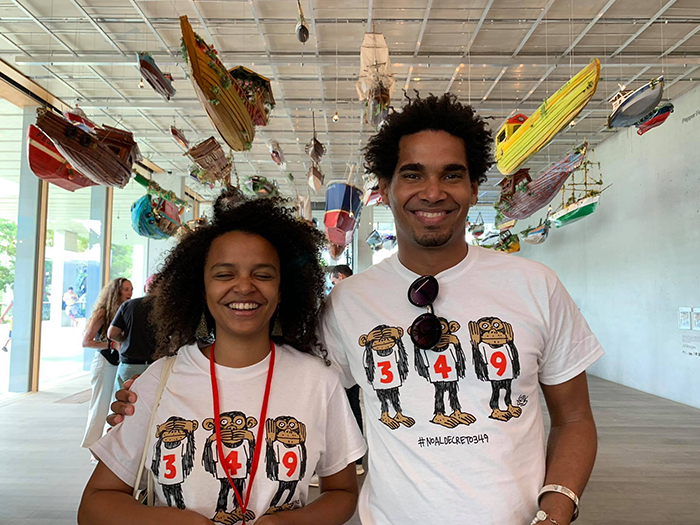
Cuban artists Luis Manuel Otero Alcantara and Yanelys Nuñez Leyva, members of the Index-award winning Museum of Dissidence
Mohamed Sameh, from the Index on Censorship Freedom of Expression Award-winning Egypt Commission on Rights and Freedoms, offered these words of solidarity: “We are shocked to know of Yanelys and Luis Manuels’s detention. Is this the best Cuba can do to these wonderful artists? What happened to Cuba that once stood together with Nelson Mandela? We call on and ask the Cuban authorities to release Yanelys and Luis Manuel immediately. The Cuban authorities shall be held responsible of any harm that may happen to them during this shameful detention.”[/vc_column_text][/vc_column][/vc_row][vc_row][vc_column][vc_basic_grid post_type=”post” max_items=”4″ element_width=”6″ grid_id=”vc_gid:1544112913087-f4e25fac-3439-10″ taxonomies=”23772″][/vc_column][/vc_row]
5 Dec 2018 | Artistic Freedom, Artistic Freedom Statements, Cuba, News and features
[vc_row][vc_column][vc_column_text]
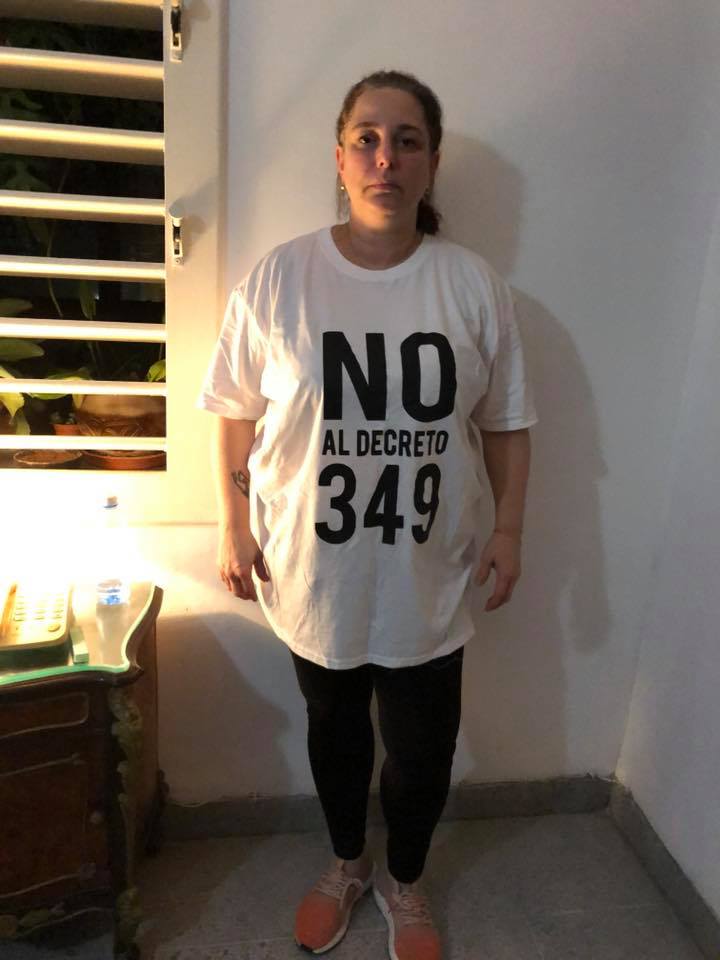
Cuban artist Tania Bruguera
Update: All arrested artists have now been released, although they remain under police surveillance. Cuba’s vice minister of culture Fernando Rojas has told the Associated Press that changes will be made to Decree 349 but has not opened dialogue with the artists involved in the campaign against the decree.
The following is an open declaration for all artists campaigning against the Decree 349, a law that will criminalise independent artists and place severe restrictions on cultural activity not authorised by the state. It will be read in solidarity at a gathering at Turbine Hall at the Tate Modern today from 1-2pm for those arrested this week for protesting the law. Those arrested include Luis Manuel Otero Alcantara and Yanelys Nuñez Leyva, members of the Index-award winning Museum of Dissidence, and Cuban performance artist Tania Bruguera. In all, 13 artists were arrested over 48 hours. Some have commenced a hunger and thirst strike.
The Cuban government intends to implement a regulation – commonly known as Decree 349 – which will subdue artistic and creative activity on the island, bringing it under the state’s strict tutelage. The content of the decree comprises two classical premises of any totalitarian state: the need for the artist to obtain prior authorisation for the exercise of his/her work and censorship of the creative process.
The execution of these two premises is to be overseen by an intricate structure of civil servants, subject to their discretion, thus reinforcing a “bureaucracy” which inhabits the language of revolutionary self-criticism.
The title of the decree reflects the particular vision that the Cuban government has about art because it refers to “the provision of artistic services”. If the purpose of art is to provide a service, then it essentially provides only to the regime and to no one else.
Art as a utilitarian artefact not only contravenes the Universal Declaration of Human Rights (Cuba is an active member of the United Nations Organisation), but also the basic principles of the United Nations for Education, Science and Culture (UNESCO).
The decree does not include anything new to the current practice of the Cuban government in the management of social engineering of its population, however, it offers a legal cover to a reactionary, ancient and regressive practice even in the field of those who consider themselves progressive. Nobody can deny the extraordinary achievement of Cuba in terms of providing basic necessities to its citizens, particularly provisions of health and education; this in spite of a setback of over fifty years, resulting from a political and economic embargo from the world’s most powerful nation. Under these conditions, creatives in Cuba were not only free to practice art but were actively promoted by the State and became a symbol of a global solidarity.
Ultimately, the freedom that is inherent to creative acts is something that a government whose only objective it is to remain in power, will be unable to tolerate. In adopting the act and implementing the decree, they will find themselves in a creative desert that will bore even themselves. The nomenclature living in their material comfort will seek to see Hollywood movies, instead of listening to their own propaganda.
Freedom of creation, a basic human expression, is becoming a “problematic” issue for many governments in the world. A degradation of fundamental rights is evident not only in the unfair detention of internationally recognised creatives, but mainly in attacking the fundamental rights of every single creator. Their strategy, based on the construction of a legal framework, constrains basic fundamental human rights that are inalienable such as freedom of speech. This problem occurs today on a global scale and should concern us all.[/vc_column_text][/vc_column][/vc_row][vc_row][vc_column][vc_basic_grid post_type=”post” max_items=”4″ element_width=”6″ grid_id=”vc_gid:1544094682847-9507be49-72bf-3″ taxonomies=”23772″][/vc_column][/vc_row]





